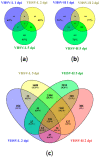Transcriptome Profiling of Oncorhynchus mykiss Infected with Low or Highly Pathogenic Viral Hemorrhagic Septicemia Virus (VHSV)
- PMID: 38257883
- PMCID: PMC10821180
- DOI: 10.3390/microorganisms12010057
Transcriptome Profiling of Oncorhynchus mykiss Infected with Low or Highly Pathogenic Viral Hemorrhagic Septicemia Virus (VHSV)
Abstract
The rainbow trout (Oncorhynchus mykiss) is the most important produced species in freshwater within the European Union, usually reared in intensive farming systems. This species is highly susceptible to viral hemorrhagic septicemia (VHS), a severe systemic disease widespread globally throughout the world. Viral hemorrhagic septicemia virus (VHSV) is the etiological agent and, recently, three classes of VHSV virulence (high, moderate, and low) have been proposed based on the mortality rates, which are strictly dependent on the viral strain. The molecular mechanisms that regulate VHSV virulence and the stimulated gene responses in the host during infection are not completely unveiled. While some preliminary transcriptomic studies have been reported in other fish species, to date there are no publications on rainbow trout. Herein, we report the first time-course RNA sequencing analysis on rainbow trout juveniles experimentally infected with high and low VHSV pathogenic Italian strains. Transcriptome analysis was performed on head kidney samples collected at different time points (1, 2, and 5 days post infection). A large set of notable genes were found to be differentially expressed (DEGs) in all the challenged groups (e.s. trim63a, acod1, cox-2, skia, hipk1, cx35.4, ins, mtnr1a, tlr3, tlr7, mda5, lgp2). Moreover, the number of DEGs progressively increased especially during time with a greater amount found in the group infected with the high VHSV virulent strain. The gene ontology (GO) enrichment analysis highlighted that functions related to inflammation were modulated in rainbow trout during the first days of VHSV infection, regardless of the pathogenicity of the strain. While some functions showed slight differences in enrichments between the two infected groups, others appeared more exclusively modulated in the group challenged with the highly pathogenic strain.
Keywords: NGS; RNA-Seq; VHS; pathogenicity; rainbow trout; transcriptomic.
Conflict of interest statement
The authors declare no conflicts of interest. The funders had no role in the design of the study; in the collection, analyses, or interpretation of data; in the writing of the manuscript; or in the decision to publish the results.
Figures





Similar articles
-
Transcriptomic and biometric parameters analysis in rainbow trout (Oncorhynchus mykiss) challenged with viral hemorrhagic septicemia virus (VHSV).BMC Genomics. 2025 Feb 28;26(1):204. doi: 10.1186/s12864-025-11300-x. BMC Genomics. 2025. PMID: 40021981 Free PMC article.
-
The Nucleoprotein and Phosphoprotein Are Major Determinants of the Virulence of Viral Hemorrhagic Septicemia Virus in Rainbow Trout.J Virol. 2019 Aug 28;93(18):e00382-19. doi: 10.1128/JVI.00382-19. Print 2019 Sep 15. J Virol. 2019. PMID: 31270224 Free PMC article.
-
The Viral Hemorrhagic Septicemia Virus (VHSV) Markers of Virulence in Rainbow Trout (Oncorhynchus mykiss).Front Microbiol. 2020 Oct 20;11:574231. doi: 10.3389/fmicb.2020.574231. eCollection 2020. Front Microbiol. 2020. PMID: 33193184 Free PMC article.
-
Differences in virulence of marine and freshwater isolates of viral hemorrhagic septicemia virus in vivo correlate with in vitro ability to infect gill epithelial cells and macrophages of rainbow trout (Oncorhynchus mykiss).J Virol. 2008 Nov;82(21):10359-65. doi: 10.1128/JVI.01009-08. Epub 2008 Aug 27. J Virol. 2008. PMID: 18753199 Free PMC article.
-
The glycoprotein, non-virion protein, and polymerase of viral hemorrhagic septicemia virus are not determinants of host-specific virulence in rainbow trout.Virol J. 2019 Mar 7;16(1):31. doi: 10.1186/s12985-019-1139-3. Virol J. 2019. PMID: 30845963 Free PMC article.
References
-
- WOAH . Manual of Diagnostic Tests for Aquatic Animals. WOAH; Paris, France: 2021. Infection with viral haemorrhagic septicemia virus.
-
- Béarzotti M., Monnier A.F., Vende P., Grosclaude J., de Kinkelin P., Benmansour A. The glycoprotein of viral hemorrhagic septicemia virus (VHSV): Antigenicity and role in virulence. Vet. Res. 1995;26:413–422. - PubMed
Grants and funding
LinkOut - more resources
Full Text Sources
Research Materials

